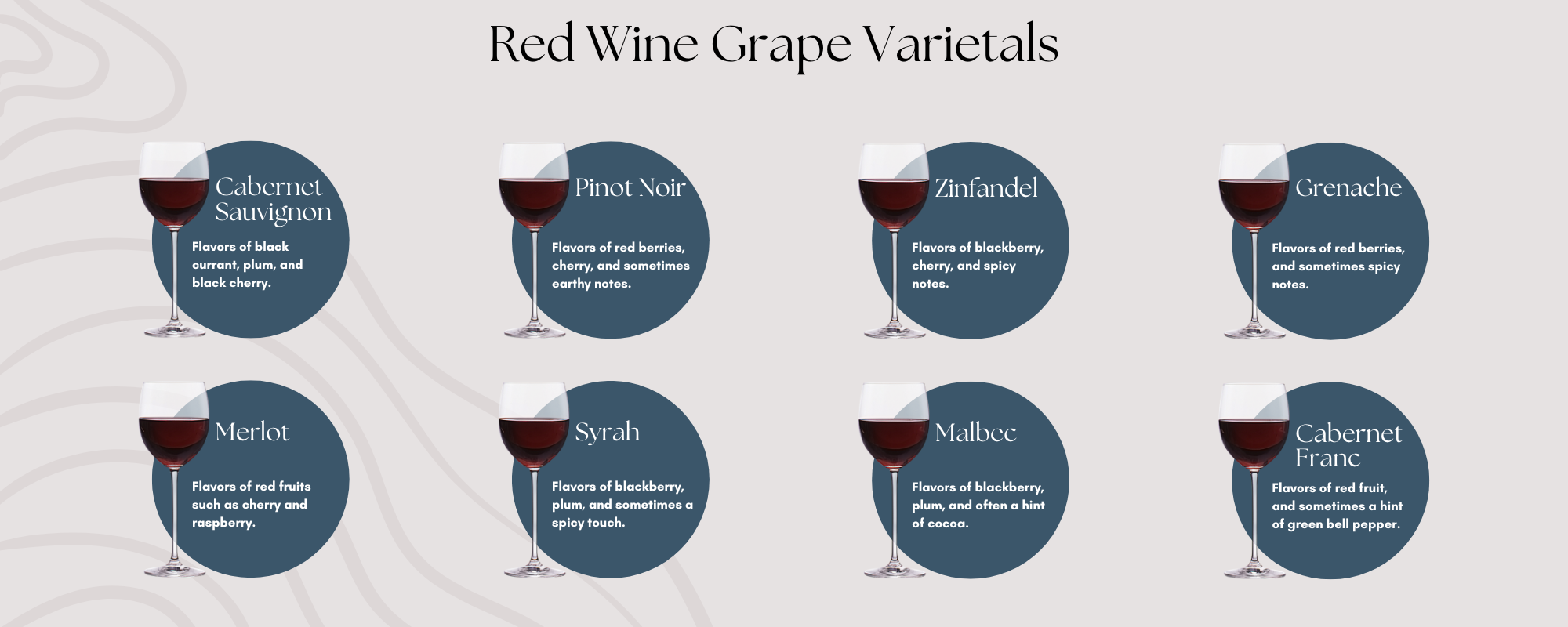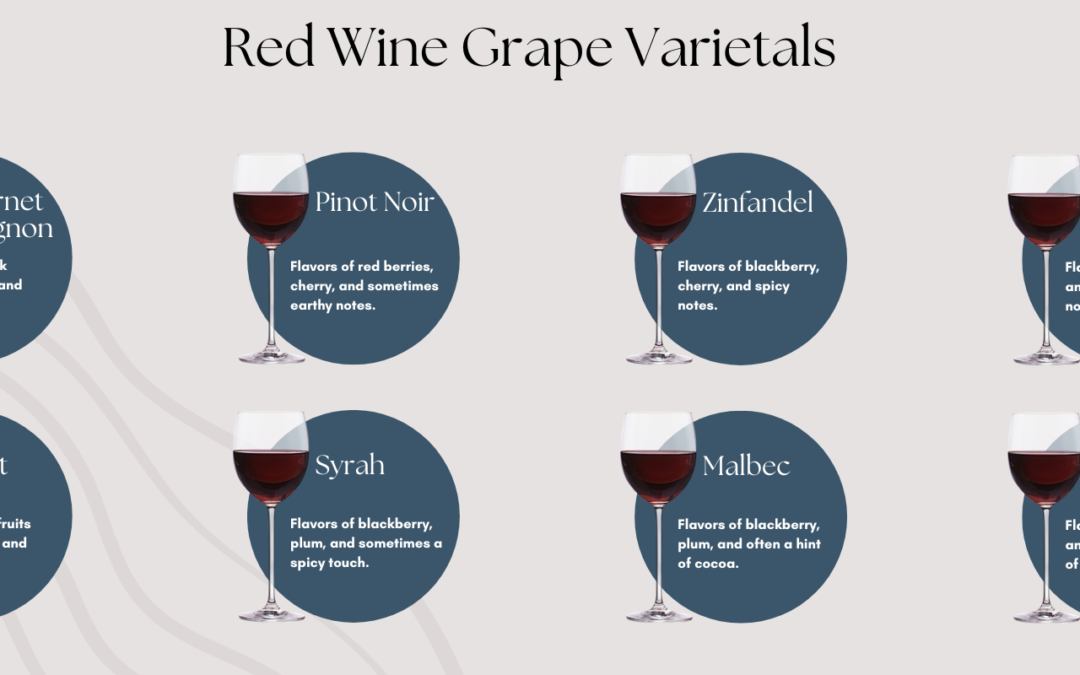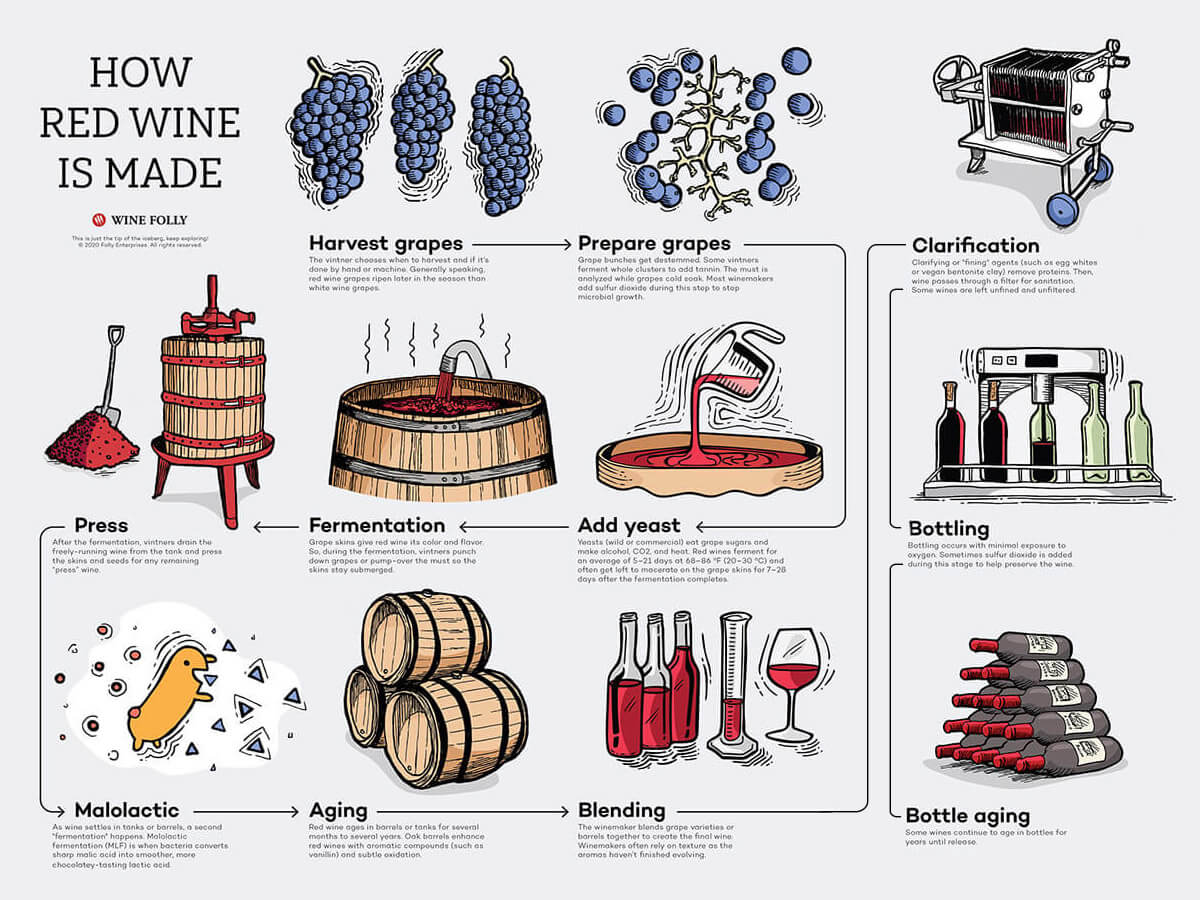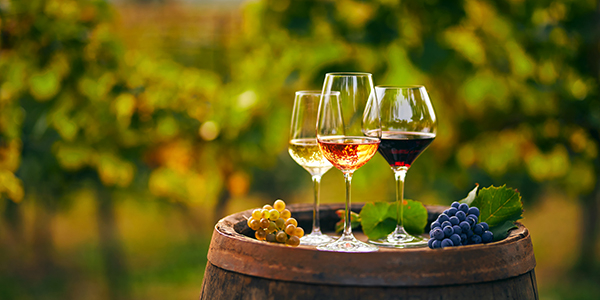Welcome to your comprehensive guide to the world of red wine. From the vineyards to your glass, we’re diving into the rich flavors, grape varietals, food pairings, and history that make red wine a timeless treasure. Whether you’re a seasoned sipper or a curious novice, join us as we guide you through the beauty that is crimson wine!
In this guide, we will be talking about:
-
How Red Wine Is Made
-
The History Behind Red Wine
-
The Different Red Wine Varietals
-
Pairing Food with Red Wine
Making red wine involves turning grape juice into a delicious alcoholic drink using a series of complex steps. Read on for a fun and simplified journey through the overall process!
Harvesting:
The winemaking process begins with the harvest of wine grapes. The timing of the harvest is crucial, as it affects the grape’s sugar, acid, and tannin levels!
Crushing:
Once harvested, the grapes are destemmed and crushed to release their juice. The method of crushing can vary, with some winemakers diverging in their methods, opting for a bold choice: preserving the grapes in partial wholeness for added structure.
Fermentation:
The crushed grapes, including the skins, and pulp, are transferred to fermentation vessels. For red wine, this often involves fermenting the grape juice along with the grape skins. Did you know that the grape skins are part of what impart the color, and add lots of flavor to the wine?
Punching Down or Pumping Over:
During fermentation, winemakers perform “punch downs” or “pump overs” to ensure that the grape skins remain in contact with the fermenting juice. This process leads to beautiful colors, tannins, and rich flavor compounds from the skins!
Punch downs push the caps down to release the juice, pump overs take the juice from the bottom and respray it over the top of the cap!
Pressing:
After fermentation is complete, the liquid portion (known as “free-run wine”) is separated from the solid grape remnants. The remaining solids are then pressed to extract any remaining liquid, known as “press wine.” Some winemakers choose to blend these components to achieve the desired characteristics!
Aging:
The wine is moved to barrels or tanks to mature. Wine makers often use American or European oak barrels to age wine because of the delicious aromas and flavors the barrels add to the wine. Think of your favorite oaky cab!
Blending:
Have you ever wondered how wines get their specific and complex flavors? Winemakers often achieve flavor diversity by blending wines from different barrels or batches to achieve the desired flavor profile and balance. This step is crucial for achieving consistency in large-scale production!
Filtration and Bottling:
After the winemaking magic happens, extra steps are taken to filter out any lingering solids or sediment. The wine is then bottled and sealed.
Aging in Bottle:
Red wines often continue to develop and improve in the bottle, so they may be aged for a period before release to the market. The aging process typically lasts between 1-2 years before being sold!
The History Behind Red Wine
Red wine has a fascinating history closely tied to the development of winemaking, grape growing, and human civilization. Here’s a simplified journey through its past:
Ancient Times:
Winemaking traces back to around 6000 BC in places like the Caucasus and Mesopotamia (modern Iran and Iraq). It likely started accidentally when crushed grapes fermented, creating alcohol.
Egypt and the Mediterranean:
Ancient Egyptians and Phoenicians helped spread vine cultivation and winemaking. Wine became a symbol of status and featured prominently in religious ceremonies.
Greece and Rome:
The Greeks and Romans turned wine into an art form. Philosophers like Hippocrates praised its medicinal properties, and social gatherings often centered around wine. Romans refined winemaking and spread vineyards across their empire.
Renaissance and Global Expansion:
The Renaissance sparked renewed interest in winemaking, and exploration expanded wine production beyond Europe, reaching the New World.
18th and 19th Centuries:
Winemaking advanced with techniques like using oak barrels for aging. The late 19th century faced the phylloxera epidemic, leading to the replanting of European vineyards with resistant American rootstocks.
20th Century:
Technological developments like stainless steel tanks and temperature control transformed winemaking. “New World” regions like California, Australia, and South America rose alongside traditional European wine making areas.
Modern Era:
Today, red wine is a global delight. Winemakers focus on sustainability, organic practices, and understanding terroir—the impact of the environment— on wine characteristics.
Throughout history, red wine has been more than a drink. It’s been a cultural symbol, inspiring art and literature and enriching daily rituals. The diverse world of red wines reflects various grapes, traditions, and regional influences that have shaped its captivating journey!
What Are The Different Types of Grape Varietals?

The world of red wine is diverse, with numerous grape varietals contributing to a wide range of flavors and styles. We’ve broken down some of the main red wine grape varietals for you:
Cabernet Sauvignon:
Known for its boldness and structure, Cabernet Sauvignon often features flavors of blackcurrant, plum, and black cherry.
Merlot:
Merlot exhibits softness and approachability, showcasing flavors of red fruits such as cherry and raspberry.
Pinot Noir:
People know Pinot Noir for its elegance and versatility. It exhibits flavors of red berries, cherry, and sometimes earthy notes.
Syrah/Shiraz:
Syrah, also called Shiraz in Australia, makes strong, rich wines with tastes of blackberry, plum, and sometimes a spicy touch.
Zinfandel:
Zinfandel is known for its bold and fruity profile, with flavors ranging from blackberry and cherry to spicy notes. It’s particularly associated with California, especially in the context of “Zinfandel” wines.
Malbec:
Malbec produces deep, dark wines with flavors of blackberry, plum, and often a hint of cocoa. It’s notably associated with Argentina, where it has gained international acclaim.
Grenache:
Grenache produces wines with a range of styles, from light and fruity to rich and full-bodied. Flavors include red berries, especially raspberry, and sometimes spicy notes.
Cabernet Franc:
Cabernet Franc is often used in Bordeaux blends. It adds floral scents, red fruit tastes, and sometimes a hint of green bell pepper.
These are only a few examples of red wine grapes that contribute to the worldwide range of red wines. Additionally, many other types of red wine grapes exist in the world. The characteristics of the wine can also be influenced by factors such as terroir, climate, and winemaking techniques!
Pairing Red Wine with Food
Matching red wine with food is a fun adventure that enhances the dining experience and takes it to another level. In this section, we’ll discuss how to perfectly pair red wine with your favorite dishes for a harmonious combination. The key to paring wine and food is understanding how tannin, acid, and fruit all play a part in the final paring!
Softer Tannins will work better with lighter dishes, whereas strong tannin wines need to be parried with big, bold flavors! The amount of acid in a wine will help cut through fatty foods and give the dish a nice contrast. Below are some delicious wine & food pairings to get you started:
Classic Pairings:
Cabernet Sauvignon with Red Meat: The robust tannins and dark fruit flavors of Cabernet Sauvignon make it an excellent companion to grilled steaks and rich beef dishes.
Pinot Noir with Poultry or Earthy Dishes: The versatility of Pinot Noir allows it to complement the lighter flavors of poultry or the earthy notes in dishes like mushroom risotto.
Regional Harmony:
Bordeaux Reds with French Cuisine: Bordeaux blends, featuring Cabernet Sauvignon and Merlot, harmonize beautifully with classic French dishes like Coq au Vin or Beef Bourguignon.
Chianti with Italian Delights: Sangiovese-based Chianti wines are a natural fit for Italian cuisine, enhancing the flavors of pasta, tomato-based sauces, and aged cheeses.
Spicy and Bold:
Zinfandel with Barbecue: Zinfandel’s bold fruitiness and peppery notes stand up well to the smoky flavors of barbecue, creating a palate-pleasing combination.
Syrah/Shiraz with Spices: The spiciness of Syrah or Shiraz complements dishes with bold spices, such as lamb curry or Cajun cuisine.
Contrast and Complement:
Contrast with Acidity: A slightly acidic red wine, like a Chianti or Barbera, can cut through the richness of creamy dishes, creating a balance that enhances both elements.
Complement with Similarities: Pair wines and dishes with similar flavor components. For example, a Malbec with dark fruit notes can complement a chocolate dessert with similar fruity undertones.
Dessert Wines:
Port with Chocolate: The rich, sweet notes of Port wine make it a delightful partner for chocolate desserts, creating a decadent finale to your meal.
When you start your journey of red wine and food exploration, remember that personal preferences are important. The joy of pairing lies in experimenting and discovering what resonates with your taste buds!
As we finish our look into the world of red wine, we hope you’ve discovered a new love for this classic drink. Whether you’re just starting to enjoy it or you’re already a big fan, red wine has a special way of capturing attention, sparking inspiration, and creating connections. Here’s to the future, where you can explore more types of red wine, try out tasty combinations, and enjoy the happiness that red wine brings to your taste buds. Cheers to the exciting journey ahead!



